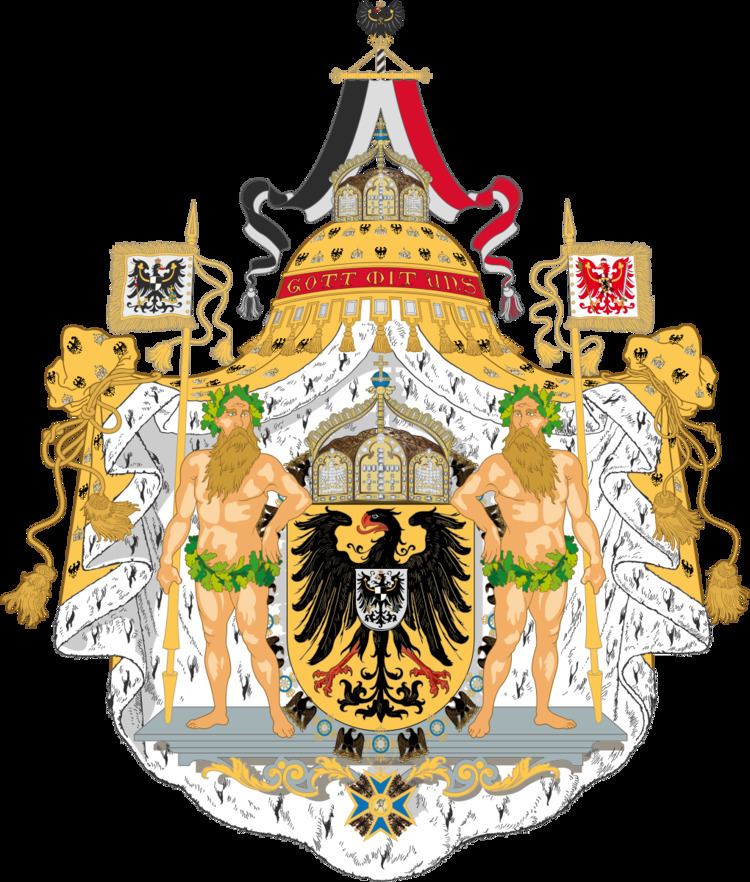First monarch Wilhelm I Formation 18 January 1871 Residence Stadtschloss, Berlin | Last monarch Wilhelm II Abolition 28 November 1918 | |
 | ||
The German Emperor (German: Deutscher Kaiser) was the official title of the head of state and hereditary ruler of the German Empire. A specifically chosen term, it was used between the 18 January 1871 proclamation of King of Prussia and President of the North German Confederation Wilhelm I as "Deutscher Kaiser" and the official abdication of Wilhelm II on 28 November 1918. The Holy Roman Emperor is sometimes also called "German Emperor" when the historical context is clear, as derived from the Holy Roman Empire's official post-1512 title of "Holy Roman Empire of the German Nation."
Contents
Following the revolution of 1918, the German head of state function was succeeded by the Reichspräsident (President of the Reich), beginning with Friedrich Ebert.
Creation
The title "German Emperor" was carefully chosen by Minister President of Prussia and Chancellor of the North German Confederation Otto von Bismarck after discussion which continued until the proclamation of Wilhelm I at the Palace of Versailles during the Franco-Prussian War. William I accepted this title grudgingly as he would have preferred "Emperor of Germany"; this had been unacceptable to the federated monarchs, and also would have signaled a claim to lands outside his reign (Austria, Switzerland, Luxembourg etc.). Emperor of the Germans, as had proposed at the Frankfurt Parliament in 1849, was ruled out by William as he considered himself a king who ruled by divine right and chosen "By the Grace of God", not by the people in a popular monarchy.
By this ceremony, the North German Confederation (Norddeutscher Bund) was transformed into the German Empire (Deutsches Kaiserreich). This empire was a federal monarchy; the emperor was head of state and president of the federated monarchs (the kings of Bavaria, Württemberg, Saxony, the grand dukes of Baden, Mecklenburg-Schwerin, Hesse, as well as other principalities, duchies and of the free cities of Hamburg, Lübeck and Bremen).
Under the imperial constitution, the empire was a confederation of states under the permanent presidency of Prussia. The King of Prussia was named in the constitution as the "President of the Confederation." Thus, the imperial crown was directly tied to the Prussian crown—something Wilhelm II discovered in the aftermath of World War I. He erroneously believed that he ruled the empire in personal union with Prussia. With the war's end, he conceded that he could not remain emperor, but initially thought he could at least retain his Prussian crown.
Full titles
The German Emperors had an extensive list of titles and claims that reflected the geographic expanse and diversity of the lands ruled by the House of Hohenzollern.
William I
His Imperial and Royal Majesty William I, By the Grace of God, German Emperor and King of Prussia; Margrave of Brandenburg, Burgrave of Nuremberg, Count of Hohenzollern; sovereign and supreme Duke of Silesia and of the County of Glatz; Grand Duke of the Lower Rhine and of Posen; Duke of Saxony, of Westphalia, of Angria, of Pomerania, Lunenburg, Holstein and Schleswig, of Magdeburg, of Bremen, of Guelders, Cleves, Jülich and Berg, Duke of the Wends and the Kassubes, of Crossen, Lauenburg and Mecklenburg; Landgrave of Hesse and Thuringia; Margrave of Upper and Lower Lusatia; Prince of Orange; Prince of Rügen, of East Friesland, of Paderborn and Pyrmont, of Halberstadt, Münster, Minden, Osnabrück, Hildesheim, of Verden, Cammin, Fulda, Nassau and Moers; Princely Count of Henneberg; Count of Mark, of Ravensberg, of Hohenstein, Tecklenburg and Lingen, of Mansfeld, Sigmaringen and Veringen; Lord of Frankfurt.
Frederick III
His Imperial and Royal Majesty Frederick III, By the Grace of God, German Emperor and King of Prussia, Margrave of Brandenburg, Burgrave of Nuremberg, Count of Hohenzollern, Duke of Silesia and of the County of Glatz, Grand Duke of the Lower Rhine and of Posen, Duke of Saxony, of Angria, of Westphalia, of Pomerania and of Lunenburg, Duke of Schleswig, of Holstein and of Crossen, Duke of Magdeburg, of Bremen, of Guelderland and of Jülich, Cleves and Berg, Duke of the Wends and the Kashubians, of Lauenburg and of Mecklenburg, Landgrave of Hesse and in Thuringia, Margrave of Upper and Lower Lusatia, Prince of Orange, of Rugen, of East Friesland, of Paderborn and of Pyrmont, Prince of Halberstadt, of Münster, of Minden, of Osnabrück, of Hildesheim, of Verden, of Kammin, of Fulda, of Nassau and of Moers, Princely Count of Henneberg, Count of the Mark, of Ravensberg, of Hohenstein, of Tecklenburg and of Lingen, Count of Mansfeld, of Sigmaringen and of Veringen, Lord of Frankfurt.
William II
His Imperial and Royal Majesty William II, By the Grace of God, German Emperor and King of Prussia, Margrave of Brandenburg, Burgrave of Nuremberg, Count of Hohenzollern, Duke of Silesia and of the County of Glatz, Grand Duke of the Lower Rhine and of Posen, Duke of Saxony, of Angria, of Westphalia, of Pomerania and of Lunenburg, Duke of Schleswig, of Holstein and of Crossen, Duke of Magdeburg, of Bremen, of Guelderland and of Jülich, Cleves and Berg, Duke of the Wends and the Kashubians, of Lauenburg and of Mecklenburg, Landgrave of Hesse and in Thuringia, Margrave of Upper and Lower Lusatia, Prince of Orange, of Rugen, of East Friesland, of Paderborn and of Pyrmont, Prince of Halberstadt, of Münster, of Minden, of Osnabrück, of Hildesheim, of Verden, of Kammin, of Fulda, of Nassau and of Moers, Princely Count of Henneberg, Count of the Mark, of Ravensberg, of Hohenstein, of Tecklenburg and of Lingen, Count of Mansfeld, of Sigmaringen and of Veringen, Lord of Frankfurt.
